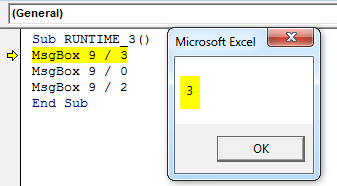
If WorksheetFunction.SumIf(Sheets("ExpLedgers").Range("$H:$H"), DataArr(R1, 1), Sheets("ExpLedgers").Range("$F:$F")) = 0 And Grp "" Then Sheets(StruArr(R, 2)).Cells(C, 1) = XtraSp & DataArr(R1, 2) XtraSp = Sheets(StruArr(R, 2)).Cells(Grp, 1) GrpRows = ActiveSheet.Cells(Rows.Count, "A").End(xlUp).Rowįor R = 1 To UBound(StruArr, 1) ' First StruArray dimension is rows.ĭo Until DataArr(Grp, 1) = DataArr(R1, 3)ĭo Until Trim(Sheets(StruArr(R, 2)).Cells(Grp, 1)) = XtraSp 'get the total of group in next to next columnĭim StruArr() As Variant 'Create and store once all data of GroupStrucĭim DataArr() As Variant 'Get all the Data and seek in this of whose Belongs to in ID for Columnar Display of Heads

'in every 0th group sheets pint all group in order to printsrlno wise sheets of 0th group in costsheet templates Private Sub CommandButton1_Click()'This procedure create diff.
#Excel vba on error resume next pops up error mesage code#
Giving source code as well as worksheet sample data so as to clearly understand the problem to responded. Procedure starts with ON ERROR RESUME NEXT to skips all error.īut at some point I want to change that status from ON ERROR RESUME NEXT to ON ERROR GOTO NX MsgBox "UNKNOWN ERROR - Error# " & Err.Number & " : " & Err.I have one procedure in excel vba code. MsgBox ("You attempted to divide by zero!") Select Case Err.Number ' Evaluate error number. On Error GoTo ErrorHandler ' Enable error-handling routine. Specifies that when a run-time error occurs, the control goes to the statement immediately following the statement where the error occurred, and the execution continues from that point. The specified line must be in the same procedure as the On Error statement, or a compile-time error will occur.ĭisables the enabled error handler in the current procedure and resets it to Nothing.ĭisables the enabled exception in the current procedure and resets it to Nothing. On Error Įnables the error-handling routine that starts at the line specified in the required line argument. Without an On Error statement, any run-time error that occurs is fatal: an error message is displayed, and the execution stops abruptly. VBA enables an error-handling routine and can also be used to disable an error-handling routine. MsgBox "Error # " & CStr(Err.Number) & " " & Err.Description In the following example, Err.Number gives the error number and Err.Description gives the error description. As a developer, if we want to capture the error, then Error Object is used. Err ObjectĪssume if we have a runtime error, then the execution stops by displaying the error message. You cannot catch those errors, because it depends on your business requirement what type of logic you want to put in your program.įor example, dividing a number by zero or a script that is written which enters into infinite loop. Instead, they occur when you make a mistake in the logic that drives your script and you do not get the result you expected. These errors are not the result of a syntax or runtime error. Logical errors can be the most difficult type of errors to track down. Runtime errors, also called exceptions, occur during execution, after interpretation.įor example, the following line causes a runtime error because here the syntax is correct but at runtime it is trying to call fnmultiply, which is a non-existing function.

For example, the following line causes a syntax error because it is missing a closing parenthesis. Syntax errors, also called as parsing errors, occur at the interpretation time for VBScript. There are three types of errors in programming: (a) Syntax Errors, (b) Runtime Errors, and (c) Logical Errors.


 0 kommentar(er)
0 kommentar(er)
